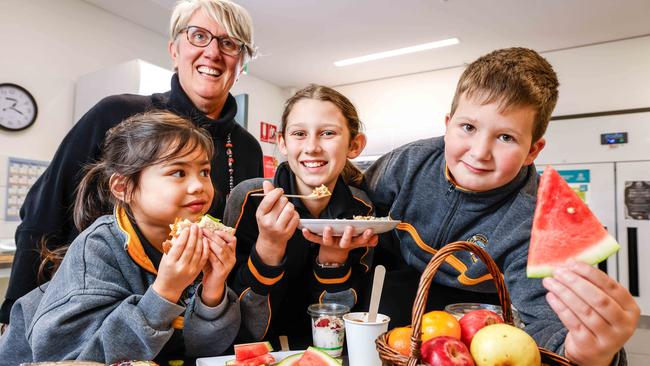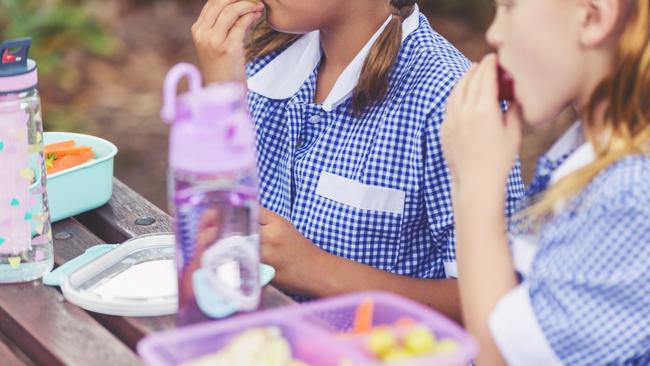New SA food and drink policies to tackle obesity
A new policy to combat childhood obesity by limiting junk food advertising on South Australian public transport has won support from health experts as a step towards better health.

SA News
Don't miss out on the headlines from SA News. Followed categories will be added to My News.
A new approach to tackling childhood obesity in South Australia is being applauded by one of the key policy-shapers at the state’s independent health and medical research institute.
Professor Caroline Miller, the director of SAHMRI’s Health Policy Centre, says the state government’s move to ban the advertising of unhealthy food and drink products on government-owned public transport is a “step in the right direction” to help curb diet-related health issues.
The Restriction of Unhealthy Food and Drink Advertising on SA Government Transit Assets policy, set to come into effect from July 1, prohibits a range of junk food items from being displayed on Adelaide’s buses, trains and trams.
Chocolate, lollies, desserts, ice creams, soft drinks and chips will all be among the products banned from display, with the measure designed to limit children’s exposure to unhealthy food and drink advertising.
According to the National Health Survey 2021-22, almost 66 per cent of Australian adults and 28 per cent of children are considered to be overweight or obese.
Professor Miller says there is immense pressure on health systems “struggling to manage demand from burdens of chronic diseases” – making the advertising restrictions a welcome move. “I’m supportive of the decision to restrict unhealthy food and drink advertising on government public transport assets,” she says.
“This policy is about protecting children’s health, preventing future obesity and diet-related chronic diseases.”

Professor Miller says there are clear links between advertising, unhealthy eating and disease onset.
“Australia’s children are currently getting between a third and 40 per cent of their daily intake from ‘discretionary’ foods,” she says.
“Research shows us that children are inundated with advertising for unhealthy food and drinks as they go about their daily lives.
“We know that exposure to unhealthy food advertising leads to higher intake of these foods. Higher intake of unhealthy food and drinks contributes to overweight and obesity and diet-related chronic diseases such as diabetes, heart disease and cancer.
“For individual people and families this impacts on their daily living and their wellbeing.
“It means they are dealing with the management and treatment of those illnesses, and very sadly people are losing their family members early.”
The World Health Organisation and Australia’s leading health agencies – as well as Australia’s National Obesity and Preventive Health strategies – all recommend a comprehensive suite of policies to reduce children’s exposure to unhealthy food and drink marketing, Professor Miller says.
“We all want to live in communities that support people to be active, healthy and well. But right now, the environment that surrounds us is putting our health at risk. This policy is a step in the right direction.
“Sadly, overweight and obesity have overtaken tobacco smoking as Australia’s leading causes of illness and premature death.
“Two thirds of adults and one in four children are living with overweight and obesity and this has risen dramatically in recent decades.
“This is major public health problem that warrants public health solutions.”
Professor Miller says dietary intake is heavily influenced by a food environment that is “readily available, affordable and heavily marketed to us”.
“Unfortunately, ultra-processed foods and sugary drinks are cheap, readily available and heavily promoted,” she says.
“Unhealthy food environments also work against parents – they make it harder for parents who are trying to curb the amount of unhealthy food their kids consume, when kids ‘pester’ their parents for food they see advertised.
“Unhealthy food environments also make it harder for adults who are trying to eat healthily, if healthy choices are not readily available at reasonable prices in a range of settings.”
Nutritious eating linked to academic advances
New recommended food and drink standards are introducing good eating decisions and habits to school-age children to support improved academic outcomes.
The Right Bite food and drink supply standards, developed in partnership with Preventive Health SA, assists any South Australian government schools to select food and drinks to provide or supply to students.
The standards promote healthy eating through classifying products into four categories according to their nutritional value – green (fruits, vegetables, cereals), amber (processed meats, full-fat dairy and snack foods), red one (cakes and pastries) and red two (soft drinks, chocolate and lollies).
The standards recommend school menus supply 60 per cent of food and drinks from the green category and 40 per cent from the amber category.
Red one products should be limited to twice per term while red two food and drinks should not be supplied.

“Research consistently shows that healthy eating is linked to better academic outcomes,” says Dr Natasha Schranz, director engagement and wellbeing, Department for Education.
“Forty per cent of a child’s daily energy intake occurs at school, which means schools do play that critical role in creating, promoting and modelling healthy eating behaviours.
“The Right Bite standards assists schools with decisions around food and drink choices wherever food is provided or sold.
“Providing healthier food options in schools helps to create that positive food culture, leading to improved healthy outcomes.”
Students embracing a healthy diet in school are in turn spreading a positive eating message to friends and family out of school.
“We know that it’s not necessarily individualised behaviour but the environments within which we live, work and play that drive our choices, and so creating healthy eating environments is pertinent to supporting a healthy diet,” Dr Schranz says.
“This is what the Right Bite guidance does: it helps to create that school environment that promotes those food choices for students and also their families, because they’re also interacting with things like the canteen menu. It’s role modelling healthy eating choices out to families as well.”
Right Bite has been well received by schools in South Australia, with more than 30 per cent of canteen managers engaging in online training, more than 200 canteen guides released and many schools using the online resources and tools.
“It’s not a mandatory policy – we put the information out to sites and support them to implement within their local context,” Dr Schranz says.
“It can be harder for some sites if they’re starting with more challenges than others. Our advice is to start small – don’t try to do everything at once.
“We know it can be challenging to shift practices but taking small steps is a great way to start. Maybe it’s trying to green up items already on the canteen or OSHC menu, such as adding more salad to products or changing how it’s cooked.”
As well as changing what’s on canteen and tuckshop menus, the Department supports schools other strategies to ensure their students can access and learn about foods that help them thrive.
School breakfast programs are encouraged and supported to offer staple foods such as cereal, bread, milk and fruit, while food security grants are offered to schools to address food insecurity, such as building school gardens and cooking programs, and curriculum resources are developed to guide teachers with up-to-date and engaging information.

Calls to junk the junk
A new partnership between Preventive Health SA and the Department for Infrastructure and Transport aims to create a healthier South Australian community.
From July 1, unhealthy food and drink advertising will be prohibited on public transport to reduce its exposure to South Australians.
“We know from decades of research that exposure to unhealthy food advertising is linked with unhealthy eating behaviours,” Preventive Health SA chief executive Marina Bowshall says. “This is particularly evident for children, so we need to take action.”
Around two thirds of the adult population and one third of children are living with overweight or obesity, a factor leading to significant health complications.
“Obesity has now overtaken tobacco as the leading cause of burden of disease,” Bowshall says. “With 13 per cent of hospital admissions for adults aged 45 to 79 years due to overweight and obesity, we need to look at ways to reduce this.
“How food is marketed, packaged, priced and formulated is the most significant factor impacting overweight and obesity.”
The new policy has had positive results in other jurisdictions including London and Amsterdam.
“The modelling from London is very positive and predicts incidences of obesity, diabetes and cardiovascular disease will decrease, which in turn will result in important health and economic gains,” Bowshall says.
Originally published as New SA food and drink policies to tackle obesity


